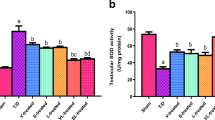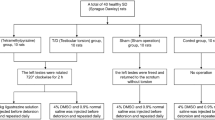Abstract
The aim of the present study was to investigate whether orchiectomy or administration of flutamide an antagonist of the testosterone receptor can reduce oxidative stress and histologic damage in the rat small bowel subjected to mesenteric ischemia/reperfusion (I/R) injury. A total of 32 Sprague-Dawley rats were divided into four groups. Group 1 was control (sham), group 2 was I/R, group 3 was I/R plus orchiectomy (orchiectomy was performed 14 days before I/R), group 4 was I/R plus flutamide (flutamide was given throughout 14 days before mesenteric IR). Rats were subjected to 45 min of mesenteric ischemia followed by 3 h of reperfusion. The levels of ileal malondialdehyde (MDA) and nitric oxide (NO) were found to be significantly lower in orchiectomy and flutamide treatment groups compared with I/R group (P < 0.05). The histopathological injury scores were consistent with the MDA and NO levels. These results suggest that castration or testosterone receptor blockade decreases the level of intestinal I/R injury in male rats and it is an another example for disease variations based on gender differences.

Similar content being viewed by others
References
Jrvinen O, Laurikka J, Salenius JP, Tarkka M (1994) Acute intestinal ischemia. A review of 214 cases. Ann Chir Gynaecol 83:22–25
Gamsu HR, Kempley ST (1997) Enteral hypoxia/ischemia and necrotizing enterocolitis. Semin Neonatol 2:245–254
Anderson CS, Jamrozik KD, Burvill PW, Chakera TM, Johnson GA, Sterwart-Wynne EG (1993) Ascertaining the true incidence of stroke experience from the Perth community stroke study 1989–1990. Med J Aust 158:80–84
Leno C, Berciano J, Combarros O, Polo JM, et al (1993) A prospective study of stroke in young adults in Cantabria, Spain. Stroke 24:792–795
Fukuda K, Yao H, Ibayashi S, Nakahara, et al (2000) Ovariectomy exacerbates and estrogen replacement attenuates photothrombotic focal ischemic brain injury in rats. Stroke 31:155–160
Squadrito F, Altavilla D, Squadrito G, et al (1997) 17 Beta-oestradiol reduces cardiac leukocyte accumulation in myocardial ischaemia reperfusion injury in rat. Eur J Pharmacol 335:185–192
Ling S, Dai A, Williams MR, Myles K, et al (2002) Testosterone enhances apoptosis-related damage in human vascular endothelial cells. Endocrinology 143:1119–1125
Muller V, Losonczy G, Heemann U, et al (2002) Sexual dimorphism in renal ischemia-reperfusion injury in rats: possible role of endothelin. Kidney Int 62:1364–1371
Yang SH, Perez E, Cutright J, Liu R (2002) Testosterone increases neurotoxicity of glutamate in vitro and ischemia-reperfusion injury in an animal model. J Appl Physiol 92:195–201
Doumas BT, Bayse DD, Carter RJ, Peters T Jr, Schaffer R (1981) A candidate reference method for determination of total protein in serum. I. Development and validation. Clin Chem 27:1642–1650
Yoshioka T, Kawada K, Shimada T (1979) Lipit peroxidation in maternal and cord blood and protective mechanism against activated-oxygen toxicity in the blood. Am J Obstet Gynecol 135:372–376
Cortas NK, Wakid NW (1990) Determination of inorganic nitrate in serum and urine by a kinetic cadmium-reduction method. Clin Chem 36:1440–1443
Chiu CJ, McArdle AH, Brown R, Scott HJ, Gurd FN (1970) Intestinal mucosal lesion in low-flow states: a morphological, hemodynamic and metabolic reappraisal. Arch Surg 101:478–483
Oldham KT, Guice KS, Gore D, Gourley WK, Lobe TE (1987) Treatment of intestinal ischemia with oxygenated perfluorocarbons. Am J Surg 153:291–294
Collard CD, Gelman S (2001) Pathophysiology, clinical manifestations and prevention of ischemia-reperfusion injury. Anesthesiology 94:1133–1338
Toyokuni S (1999) Reactive oxygen species-induced molecular damage and its application in pathology. Pathol Int 49:91–102
Tunstall-Pedoe H, Morrison C, Woodward M, Fitzpatrick B, Watt G (1996) Sex differences in myocardial infarction and coronary deaths in the Scottish MONICA population of Glasgow 1985 to 1991. Presentation, diagnosis, treatment, and 28-day case fatality of 3991 events in men and 1551 events in women. Circulation 93:1981–1992
Paganini-Hill A, Ross RK, Henderson BE (1998) Postmenopausal oestrogen treatment and stroke: a prospective study. BMJ 297:519–522
Jain A, Reyes J, Kashyap R, Dodson SF, Demetris AJ, et al (2000) Long-term survival after liver transplantation in 4,000 consecutive patients at a single center. Ann Surg 232:490–500
Diodato MD, Knoferl MW, Schwacha MG, Bland KI, Chaudry IH (2001) Gender differences in the inflammatory response and survival following haemorrhage and subsequent sepsis. Cytokine 14:162–169
Park KM, Kim JI, Ahn Y, Bonventre AJ, Bonventre JV (2004) Testosterone is responsible for enhanced susceptibility of males to ischemic renal injury. J Biol Chem 279:52282–52292
Xiao X, Liu D, Zheng S, Fu J, Zhang H, Chen L (2004) Protective effect of estrogen on intestinal ischemia-reperfusion injury in pubertal rats. J Pediatr Surg 39:1828–1831
Homma H, Hoy E, Xu Da-Zhong, et al (2005) The female intestine is more resistant than the male intestine to gut injury and inflammation when subjected to conditions associated with shock states. Am J Physiol Gastrointest Liver Physiol 288:466–472
Szabo A, Vollmar B, Boros M, Menger MD (2006) Gender differences in ischemia-reperfusion-induced microcirculatory and epithelial dysfunctions in the small intestine. Life Sci 78:3058–3065
Czyrko C, Steigman C, Turley D, et al (1991) The role of reperfusion injury in occlusive intestinal ischemia of the neonate: malonaldehyde derived fluorescent products and correlation of histology. J Surg Res 51:1–4
Kubes P (1992) Nitric oxide modulates epithelial permeability in the feline small intestine. Am J Physiol 262: G1138–G1142
Stefanutti G, Pierro A, Vivardi S, Spitz L, Eaton S (2005) Moderate hypothermia protects against systemic oxidative stress in a rat model of intestinal ischemia and reperfusion injury. Shock 24:159–164
Naito Y, Takagi T, Ichikawa H, et al (2004) A novel potent inhibitor of inducible nitric oxide inhibitor, ONO-1714, reduces intestinal ischemia-reperfusion injury in rats. Nitric oxide 10:170–177
Takada K, YamashitaK, Sakurai-Yamashita Y, et al (1998) Participation of nitric oxide in mucosal injury of rat intestine induced by ischemia-reperfusion. J Pharmacol Exp Ther 287:403–407
Barocelli E, Ballabeni V, Ghizzardi P (2006) The selective inhibition of inducible nitric oxide synthase prevents intestinal ischemia-reperfusion injury in mice. Nitric Oxide 14:212–218
Karabulut AB, Kirimlioglu V, Kirimlioglu H, et al (2006) Protective effects of resveratrol on spleen and ileum in rats subjected to ischemia-reperfusion. Transplant Proc 38:375–377
Matsuda K, Ruff A, Morinelli TA, Mathur RS, Halushka PV (1994) Testosterone increases thromboxane A2 receptor density and responsiveness in rat aortas and platelets. Am J Physiol 267(Heart Circ Physiol 36):H887–H893
Ajayi AA, Mathur R, Halushka PV (1995) Testosterone increases human platelet thromboxane A2 receptor density and aggregation responses. Circulation 91:2742–2747
Wang M, Tsai BM, Kher A, et al (2005) Role of endogenous testosterone in myocardial proinflammatory and proapoptotic signaling after acute ischemia-reperfusion. Am J Physiol Heart Circ Physiol 288:H221–H226
Angele M K, Wichmann MW, Ayala A, Cioffi WG, Chaudry IH (1997) Testosterone receptor blockade after hemorrhage in males: restoration of the depressed immune function and improved survival following subsequent sepsis. Arch Surg 132:1207–1214
Remmers DE, Wang P, Cioffi WG, et al (1997) Testosterone receptor blockade after trauma-hemorrhage improves cardiac and hepatic functions in males. Am J Physiol 273:H2919–H2925
O’Connor JC, Frame SR, Ladics GS (2002) Evaluation of a 15-day screening assay using intact male rats for identifying steroid biosynthesis inhibitors and thyroid modulators. Toxicol Sci 69:79–91
Yu HP, Yang S, Choudhry MA, Hsieh YC, Bland KI, Chaudry IH (2005) Mechanism responsible for the salutary effects of flutamide on cardiac performance after trauma-hemorrhagic shock: upregulation of cardiomyocyte estrogen receptors. Surgery 138:85–92
Yu HP, Choudhry MA, Shimizu T, et al (2006) Mechanism of the salutary effects of flutamide on intestinal myeloperoxidase activity following trauma-hemorrhage: up-regulation of estrogen receptor-{beta}-dependent HO-1. J Leukoc Biol 79:277–284
Author information
Authors and Affiliations
Corresponding author
Rights and permissions
About this article
Cite this article
Akçora, B., Altuğ, E., Kontaş, T. et al. Orchiectomy or testosterone receptor blockade reduces intestinal mucosal damage caused by ischemia-reperfusion insult. Pediatr Surg Int 24, 337–341 (2008). https://doi.org/10.1007/s00383-007-2062-z
Accepted:
Published:
Issue Date:
DOI: https://doi.org/10.1007/s00383-007-2062-z




